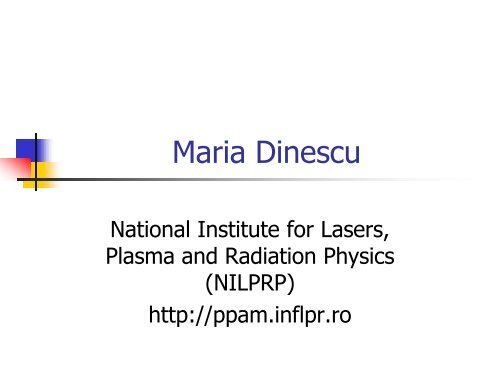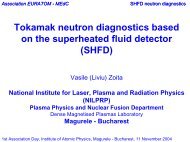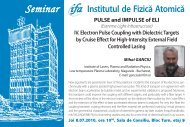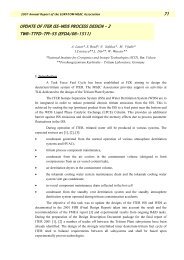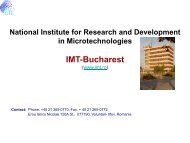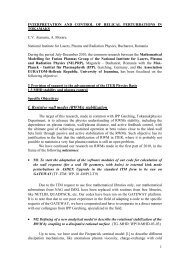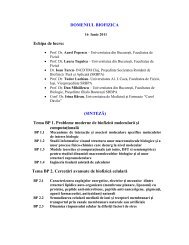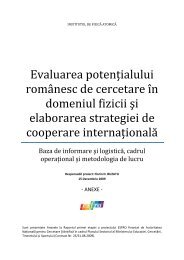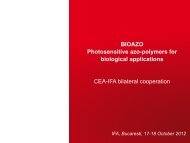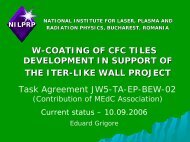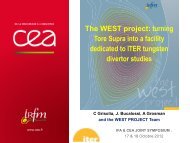Maria Dinescu - IFA
Maria Dinescu - IFA
Maria Dinescu - IFA
Create successful ePaper yourself
Turn your PDF publications into a flip-book with our unique Google optimized e-Paper software.
<strong>Maria</strong> <strong>Dinescu</strong><br />
National Institute for Lasers,<br />
Plasma and Radiation Physics<br />
(NILPRP)<br />
http://ppam.inflpr.ro
NILPRP (National Institute for Lasers, Plasma and<br />
Radiation Physics) Bucharest, Romania<br />
• In the top position in the country as importance (dimension and<br />
scientific contribution)<br />
• Main field: lasers and plasma physics and applications<br />
• 450 peoples: 235 scientists, 60 PhD students<br />
• Five departments<br />
• Laser Department (PPAM)<br />
• Laboratory of Solid State and Quantum Electronics<br />
• Plasma Physics and Nuclear Fusion Laboratory<br />
• Low Temperature Plasma Laboratory<br />
• Accelerators Laboratory<br />
• Laser Metrology<br />
• Involved in national and international (EURATOM, FP7, NATO SfP,<br />
EUREKA etc.) projects
NILPRP<br />
PHOTONIC PROCESSING OF ADVANCED MATERIALS<br />
Group (PPAM)<br />
http://ppam.inflpr.ro<br />
The group was organized starting with 1996 and in present contains 17 qualified scientists and 2 technicians.<br />
Topic<br />
The activity is focused on laser processing of matter, with applications in thin films and nanostructures with<br />
functional properties, functional polymers, protein and cell transfer for tissue engineering, chemical sensors for the<br />
detection of warfare agents.<br />
Expertise:<br />
Thin films and heterostructures obtained by PLD and RF-PLD for different electronic applications :<br />
-Ferroelectrics, piezoelectrics and relaxors for electronic, microwave and optoelectronic applications: titanates (PZT,<br />
La doped PZT, BTO, BST, etc), niobites ( SBN, PMN, NKN), tantalates (SBT, BZT, NBT).<br />
-Zinc oxide (ZnO): piezoelectric, n-type semiconductor, p-type semiconductor- ZnO/MgxZn1-xO and<br />
MgxZn1-x/ ZnO /MgxZn1-x<br />
-III-V compounds: AlN, InN, GaN and their combinations.<br />
-Heterostructures: PMN/LSCO; PZT/TiN; CN/SiCN/SiC; SBN/STON.<br />
-High-k dielectric materials: ZrO2, ZrSixOy, HfO2, HfSixOy, Nb2O5, NbSixOy, Ta2O5, TaSixOy.<br />
-Wide band gap semiconductor metallic oxide: WOx.<br />
Nanomaterials for catalytic and biological applications:<br />
- catalytic systems and porous materials fabrication by laser and conventional techniques.<br />
- nanomaterials for drug delivery.
International Projects<br />
1999-2011<br />
• Romanian Coordinator of FP 7, FP7-ICT-2009-4-247868, e-LIFT “Laser printing of<br />
organic/inorganic material for the fabrication of electronic devices” project, (2010-2012)<br />
• NATO-SfP Project Co-Director 982671 project, Polymers based piezoelectric sensor array for<br />
chemical warfare agents detection, (2007-2011)<br />
• Romanian Coordinator of FP 6, NMP3-CT-2006-033297, 3D-DEMO, Single step 3D Deposition of<br />
complex nanopatterned Multifunctional Oxides thin films, project (2006-2010) Priority 3<br />
– NMP research area: 3.4.2.2-2 “Multifunctional ceramic thin films with radically new<br />
properties”<br />
• Romanian Coordinator of FP 5 IST –2001-33326 “Piezoelectric sensor arrays for<br />
biomolecular interactions and gas monitoring” (PISARRO) project (2002-2004)<br />
• NATO Linkage grant "Growth of Ferroelectric Thin Films by fs Pulsed Laser Deposition"<br />
(2003-2005)<br />
• NATO SfP Co-Director of the Project 97-1934, “ Laser Based Clean Technologies for Smart<br />
Sensor Applications”, (1999-2002)
RF Assisted Pulsed Laser Deposition<br />
Experimental set-up
Fundamentals of the MAPLE process<br />
Most of the laser energy is absorbed by the volatile matrix:<br />
• photochemical decomposition can be minimized<br />
Frozen<br />
target<br />
Laser<br />
light<br />
Thin film<br />
of<br />
polymer/<br />
protein<br />
Target<br />
holder,<br />
frozen<br />
Solvent<br />
molecules,<br />
pumped away<br />
Substrate<br />
The solvent and the solute concentration are chosen that<br />
• the solute can be dissolved without formation of clusters<br />
• no chemical or photochemical reactions between the solvent and<br />
solute
X-Y-Z processing system
X-Y-Z processing system
PPAM<br />
Processing<br />
Laboratory<br />
PHOTONIC PROCESSING OF ADVANCED MATERIALS Group (PPAM)<br />
Processing Equipments<br />
PLD and RF-PLD deposition systems<br />
12 cm<br />
x-y-z laser<br />
processing<br />
system<br />
(LIFT)
NILPRP<br />
Morphological analysis<br />
PHOTONIC PROCESSING OF ADVANCED MATERIALS Group (PPAM)<br />
Characterization Equipments<br />
Structural analysis<br />
AFM<br />
XRD<br />
Optical analysis<br />
Spectroellipsometer<br />
Dielectric and ferroelectric analysis<br />
Impedance analyzer<br />
Chemical analysis<br />
SIMS
Other equipments-INFLPR<br />
• SEM (Scanning Electron Microscope)<br />
• X-Ray diffractometer for powders, with<br />
temperature chamber<br />
• FTIR (Fourier Transform Infrared<br />
Spectroscopy)<br />
• Contact Angle Measurements<br />
• Plasma Spectroscopy<br />
• ….
Laser Induced Forward Transfer (LIFT)<br />
Laser light is focused on<br />
the target interface<br />
An expelling process<br />
takes place<br />
Ejected material is deposited<br />
on the receiving substrate<br />
• Precise and high density patterns<br />
• High spatial resolution<br />
• Contact or Non-contact, rapid, automated method<br />
• Flexibility as working distances, target material, size of the transferred droplets<br />
• No significant damage to transferred material under specific conditions …
OUR APPROACH: LIFT using a sacrificial release layer (TP)<br />
/Polymer<br />
TRIAZENE POLYMER<br />
Advantages<br />
Target<br />
(Nagel et al., Macromolecular Chemistry and Physics, 2007)<br />
•Avoid direct irradiation of sensitive<br />
material<br />
•After laser radiation large amount<br />
of gaseous products that acts as<br />
carrier for larger ablation products
Printing on sensor matrices<br />
Polymer λ Ф<br />
[mJ/cm 2 ]<br />
Bck<br />
pressure<br />
[mbar]<br />
Film<br />
thickne<br />
ss [nm]<br />
PIB 266 nm 0.2 ~ 10 -4 ~ 60<br />
PEI 0.4<br />
PECH 0.6<br />
XeCl, 308 nm, 1 Hz, Ф=400-500 mJ/cm 2 , TP 100nm<br />
PIB PEI<br />
PEI PECH<br />
DONOR<br />
DONOR<br />
DONOR<br />
RECEIVER<br />
400 µm 400 µm 400 µm<br />
15
Sensor array responses to simulant DMMP and EA<br />
2-port SAW resonators operating at 392 MHz.<br />
The interdigital transducers were shaped<br />
with a Gaussian apotization, with a wavelength<br />
of 8 and fingers overlap of 450µm, while the cavity<br />
length was 1276 µm.<br />
Frequency response against time of PEI, PIB and PECH<br />
polymers to different concentrations of DMMP.<br />
The frequency shift normalized to the central frequency<br />
(about 392 MHZ).
Sensor array responses to sarin nerve agent<br />
Tests carried aut at CBRN military base (Bucharest)<br />
The testing setup of SAW sensors with sarin gas<br />
Time response of a PIB coated sensor to<br />
4.6 ppm of Sarin/<br />
1.78 ppm of Sarin<br />
Response curve for PEI, PIB and PECH<br />
coated SAW sensors to<br />
different concentrations of Sarin<br />
17
NOT limited to polymer materials<br />
Examples of various materials<br />
Quantum dots, Xu et al,<br />
Nanotech (2007)<br />
Functional OLEDs, R. Fardel et al,<br />
Appl. Phys. Lett. (2007)<br />
Al, R. Fardel et al,<br />
Appl. Surf. Sci. (2007)<br />
GdGaO, Banks et al., (2008)<br />
Polystyrene microbeads, A. Palla-Papavlu et<br />
al., JAP (2010)<br />
Mammalian cells,<br />
Doraiswamy et al., Appl.Surf. Sci.(2006)<br />
Liposomes, A. Palla-Papavlu et al, Appl. Phys. A (2011)<br />
18
Furthermore: Polymer micropatterning for cellular behavior studies<br />
KEY PATTERNING PARAMETERS<br />
Laser fluence – 350 – 550 mJ/cm 2<br />
Thickness ratio PEI to TP – 150 nm TP/100 nm PEI<br />
(PEI thickness > TP thickness)<br />
Transfer distance – contact<br />
Minimum thickness of the TP layer – 100 nm<br />
Laser fluence mJ/cm 2<br />
550 500 450 400 350<br />
MATERIALS<br />
Polyethilene glycol (PEG)-Repellent for cells<br />
Polyethileneimine (PEI)-attachment vector<br />
Growth medium: 10 % FCS and 0.1 %<br />
penicilin/steptomicin<br />
Trypsyn-EDTA solution 0.25 and 0.02 in PBS<br />
DMEM with phenol red<br />
SH-SY5Y human neuroblastoma cells cultured in<br />
FCS-DMEM<br />
DONOR<br />
RECEIVER<br />
20 µm 20 µm<br />
Polymer spatially controlled micro patterning for cellular behavior study, V.<br />
Dinca et al, APA, 2011
Microfabrication of polystyrene microbead arrays by laser induced forward transfer, A. Palla-Papavlu et al, JAP, 2010<br />
Other polymers: Polystyrene microbeads<br />
(PS-µbead) microarrays<br />
Applications:<br />
Biosensing<br />
Bioseparation<br />
Biomolecule screening<br />
Experimental:<br />
Donor: PS-microbeads (size: 8 µm)<br />
Receiver: Thermanox coverslips<br />
Patterning system: XeCl, 308 nm,<br />
30ns, 1Hz<br />
Fluence: 80 mJ/cm 2 – 3.5 J/cm 2<br />
100 nm thick TP film as DRL<br />
Scale bar is 100 µm.
Polymer micropatterning for cellular behavior studies: Parameters optimization<br />
a) PEI array in cell medium<br />
b) SH-SY5Y distribution on patterned surfaces after one hour<br />
c) After one day in vitro. A clear clustering of neurons into aggregates is visible on the PEI pixel<br />
Average number of observed<br />
interconnecting neurite fascicles vs.<br />
the separation distance between the<br />
transferred PEI-pixels.<br />
a) PEI array in cell culture medium<br />
b) Neural cells attached on the substrate<br />
after 3 days in vitro. (scale bar is 200 µm)<br />
Polymer spatially controlled micro patterning for cellular behavior study, V. Dinca et al., submitted 2010
Liquid printing<br />
Liquid printing
1. Influence of DRL thickness – 60 nm, 150 nm and 350 nm<br />
2. Laser fluence<br />
3. Different glycerol concentrations (10 – 70 %)<br />
4. Time resolved imaging for 308 nm and 193 nm<br />
– laser fluences and glycerol concentration<br />
water + glycerol (50:50)<br />
scale bar is 40 µm.
International Cooperations<br />
• PSI Villigen –Thomas Lippert (ETH<br />
Zurich)<br />
• “OMCorbino” Institute for Acoustics and<br />
Sensors-CNR, Italy<br />
• Naval Research Laboratory, USA<br />
• FORTH-IESL Crete
http:ppam.inflpr.ro


